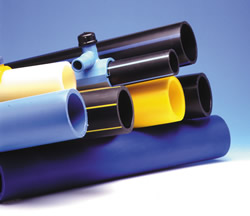How can I verify the origin of the pipe and fittings?
National and International standards require that the PE pipe and fittings are clearly marked with the grade of PE from which they are manufactured on the outer surface together with other information including: manufacturer's name or trade mark; code for the compound used; diameter and pressure rating; and date, or a code, of manufacture. This information allows traceability through the manufacturer's Quality Assurance system to determine further details as necessary, e.g. grade of the raw material used, batch test results, process conditions, etc.
Additionally, for specific applications, e.g. gas and potable water distribution, some Standards require that pipes be manufactured within a specific colour range to differentiate from pipes intended for other applications. Typically the colours are:
Gas: Yellow pipe
Black pipe with yellow stripes
Water: Blue pipe
Black pipe with blue stripes
Traceability is an integral part of modern, sophisticated, Quality Assurance systems used for PE pipe networks. The systems available, and mandatory at many end-users, enable tracing through the whole process, from the resin batch at the PE producer, through pipe extrusion, the utility company and the installation contractor's operations. All installations can be traced back to the resin batch from which they were produced, with full data on the history of the pipe or fitting at any location.
The most up-to-date traceability systems are based on the use of barcodes. The barcodes can record data covering:
- fusion-jointing equipment data
- fusion-jointing equipment operator data
- site data (geographical location)
- data on fittings and pipes
- fusion-jointing parameters
- installation dates
- assembly procedures
This information on the barcodes can be affixed to the pipes and fittings insitu, and recorded in a database, ideally linked to a Geographical Information System (GIS). At any subsequent excavation or operation the barcode can be read and all data on the pipes and fittings concerned can be accessed. Similarly in planning operations and works the data is readily accessible from the GIS or database.
ISO 12176 Part 4 defines a traceability system for encoding the characteristics of the pipes, fittings, fusion-jointing equipment, fusion-jointing equipment operators and fusion-jointing protocols. It is applicable to PE pipes, fittings and valves conforming to ISO standards for gas supply piping systems and also to the assembly operation utilising methods such butt, socket and saddle fusion, electrofusion, induction fusion and mechanical jointing.
Traccoding, a database which supports ISO 12176 Part 4, has been established at www.traccoding.com
It is up to the user to create the link between the various elements in order to provide a complete traceability system. Care is necessary when determining which data are to be downloaded into the traceability system database and the minimum information to be stored in the database for later retrieval.
References
ISO 12176-4:2003 Plastics pipes and fittings - Equipment for fusion jointing polyethylene systems - Part 4: Traceability coding
ISO 4437-1:2024 Plasric piping systems for the supply of gaseous fuels - Polyethylene (PE) - Part 1: General
Gueugnaut, D. Mise en place de la traçabilité; l'exemple des conduites de gas en polyéthylène à Gaz de France. Gas, Wasser, Abwasser (GWA); SVGW Zürich, October 2003.


Pipe colour schemes (Borealis, INEOS Polyolefines)

